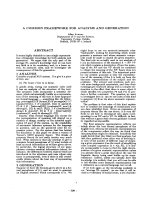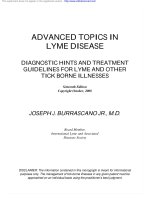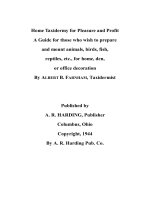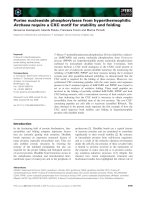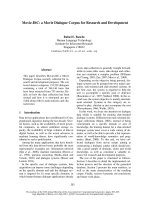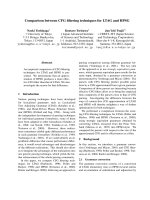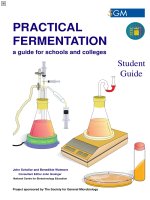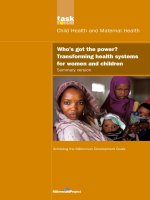Guidelines for policy-makers and service providers: experiences from Kenya, Pakistan and Brazil pot
Bạn đang xem bản rút gọn của tài liệu. Xem và tải ngay bản đầy đủ của tài liệu tại đây (2.19 MB, 67 trang )
AGRICULTURAL
AND FOOD
ENGINEERING
TECHNICAL REPORT
ISSN 1814-1137
AGRICULTURAL AND FOOD ENGINEERING TECHNICAL REPORT
7
77
Experience has shown that a basic prerequisite for successful
mechanization of the agricultural sector requires a
well-functioning supply chain. To draw lessons for achieving
this goal, the FAO Rural Infrastructure and Agro-Industries
Division commissioned three mechanization supply chain case
studies. The studies were conducted in Kenya, Pakistan and
Brazil, and the information contained in them has been used
as the basis for the analysis presented in this Technical Report.
Historically, public sector efforts to supply mechanization
services have often failed, as costs greatly exceeded income
and the maintenance of ageing machinery fleets became too
great a burden. However, it is evident that the public sector
does have a role to play in complementing the activities of
the private sector in a synergistic partnership. The main role
of the public sector is to have the vision of a national
mechanization strategy and to cultivate an enabling
environment that allows the private sector to operate
effectively. One key possibility described in the Report is that
of linking equipment supply chains across continents. This is
exemplified by an account of the evolution of no-till
technology in Brazil, which is now being successfully used by
farmers in Asia and Africa. A key stakeholder in this supply
chain development has been FAO in conjunction with the
international donor community, as they have been in a
position to take a holistic view to encourage private sector
actors and so disseminate profitable mechanization
technologies from one continent to another.
The main recommendations of the Technical Report are
aimed at policy-makers in the public sector, although there is
plenty to interest other stakeholders, especially machinery
suppliers and mechanization service providers. However, the
ultimate beneficiaries are small- and medium-scale farmers
who are the recipients of the services provided.
Farm equipment supply chains
Guidelines for policy-makers and service providers:
experiences from Kenya, Pakistan and Brazil
Farm equipment supply chains
Guidelines for policy-makers and service providers:
experiences from Kenya, Pakistan and Brazil
9 7 8 9 2 5 1 0 6 4 3 1 3
I1209E/1/10.09/1000
ISBN 978-92-5-106431-3
ISSN 1814-1137
AGRICULTURAL
AND FOOD
ENGINEERING
TECHNICAL REPORT
FOOD AND AGRICULTURE ORGANIZATION OF THE UNITED NATIONS
Rome, 2009
7
by
Brian G. Sims
FAO Consultant
and
Josef Kienzle
FAO Rural Infrastructure and Agro-Industries Division
Farm equipment supply chains
Guidelines for policy-makers and service providers:
experiences from Kenya, Pakistan and Brazil
C
M
Y
CM
MY
CY
CMY
K
I1209E_frontespizio.pdf 1 02/11/2009 17:31:16
Plates 1–5: © FAO/B.G. Sims
The designations employed and the presentation of material in this information product do
not imply the expression of any opinion whatsoever on the part of the Food and Agriculture
Organization of the United Nations (FAO) concerning the legal or development status of any
country, territory, city or area or of its authorities, or concerning the delimitation of its frontiers
or boundaries. The mention of specific companies or products of manufacturers, whether or not
these have been patented, does not imply that these have been endorsed or recommended by
FAO in preference to others of a similar nature that are not mentioned. The views expressed in
this information product are those of the author(s) and do not necessarily reflect the views of FAO.
ISBN 978-92-5-106431-3
All rights reserved. Reproduction and dissemination of material in this information product
for educational or other non-commercial purposes are authorized without any prior written
permission from the copyright holders provided the source is fully acknowledged. Reproduction of
material in this information product for resale or other commercial purposes is prohibited without
written permission of the copyright holders. Applications for such permission should be addressed
to the Chief, Electronic Publishing Policy and Support Branch, Communication Division, FAO, Viale
delle Terme di Caracalla, 00153 Rome, Italy or by e-mail to
© FAO 2009
The Agricultural and Food Engineering Technical Reports bring to a broad audience the results of
studies and field experience related to agricultural and food engineering within agrifood systems.
The reports help us take stock of what we know and clearly identify what we do not know; and
in so doing they provide information to both the public and private sectors. The Agricultural and
Food Engineering Technical Reports serve to direct further work within agrifood systems.
iii
Contents
Foreword vii
Acronyms viii
Acknowledgements x
Executive summary xi
1. Introduction and background 1
1.1 Background to the present study 4
1.2 Report structure 5
2. Supply chain and machinery management issues
and a summary of the constraints encountered 7
2.1 Supply chain focus 7
2.2. Summary of constraints 8
2.3 Testing agricultural machinery 10
3. Guidelines and opportunities for agricultural machinery
supply chain stakeholders 13
3.1 Policy-makers 14
3.2 Manufacturers, importers and retailers 17
3.3 Machinery hire services 20
3.4 Machinery repair services 21
3.5 Farmers 21
4. The case studies 25
4.1 Introduction 25
4.2 Kenya 25
4.3 Pakistan 34
4.4 Brazil 38
References 47
iv
List of figures
1. Farm power and machinery supply chain stakeholders xii
2. An example of a farm machinery supply chain in Kenya 2
3. The traditional view of supply chain processes: cycles
(the triangles represent inventories of products) 3
4. Interactions between farmers and farmer groups with public
and private sector stakeholders 13
5. Possible interrelationships in the farm power input supply chain
to farmer groups 22
6. Location of Rift Valley province, Kenya 25
7. Location of Nakuru and Laikipia districts, Kenya 25
8. Farm power and machinery supply chain for
Laikipia and Nakuru, Kenya 26
9. Input supply chain for local manufacturers and machinery retailers
in Laikipia and Nakuru, Kenya 27
10. Input supply chain for farm machinery hire service providers
in Laikipia and Nakuru, Kenya 29
11. Input supply chain for farm equipment repair services 31
12. Pakistan showing the Punjab province 34
13. Schematic supply chain of farm machinery in Pakistan:
from raw material to end users 35
14. The three states of southern Brazil:
Paraná, Santa Catarina and Rio Grande do Sul 38
15. Machinery supply chain for tractor powered equipment in southern Brazil 41
16. Production lines of a range of manufacturers of human
and animal traction (AT) powered agricultural equipment 41
17. Simplified supply chain for small- and medium-sized manufacturers
of human and animal traction powered no-till equipment
in southern Brazil 42
18. The dramatic rise in NT area (ha) in the decade 1992–2002
in Rio Grande do Sul state 43
v
List of plates
1. Policy-makers are updated on technical innovations xiii
2. Testing of a no-till planter by a manufacturer xiii
3. Machinery services for hire must closely follow farmers’ needs xiv
4. Roadside repair of combine harvester xiv
5. Farmer field-testing of a prototype planter xv
6. Direct planting through stubble maintains a permanent
protective cover on the soil 4
7. Sprayer production at the Jacto factory in Brazil 8
8. Sfil SS 10000 planter at a dynamic evaluation event of no-till seeders
in 2003 in Guaíra Paraná State, Brazil 12
9. Batch orders placed with private sector manufacturers 15
10. High density carrot crop on raised beds 16
11. Smallholder farmers practise crop establishment with jab planters 16
12. Two-row animal-drawn no-till planter of the type
now being imported into East Africa from South America 18
13. Simon Ngero explains the design of the Femo pedestrian-pulled sprayer 19
14. Direct drilling wheat into rice stubble with a Brazilian no-till seed drill 20
15. The Ndume factory near to Nakuru manufactures heavy-duty
agricultural equipment 27
16. The KickStart Moneymaker pump being manufactured by
a medium-scale manufacturer 28
17. Hammer mill production in Nairobi, Kenya 28
18. Holman Brothers imports machinery from Europe and Brazil and,
in common with other retailers, caters for larger-scale farmers 28
19. Artisan training at RTDC, Nakuru 30
20. Vertically integrated machinery manufacturers reduce outsourcing
to a minimum 35
21. Farm machinery dealer showcourt in Punjab, Pakistan 37
22. Sophisticated no-till tractor mounted planter produced by Sfil 39
23. Matracas produced by the Krupp factory as its sole product line 40
24. A hand operated sprayer being demonstrated by a Knapik company
director at his factory 40
25. The Gralha azul animal traction no-till planter and fertilizer applicator
developed at IAPAR in the mid-1980s 43
26. Fertilizer and lime distributor of the type offered free
to small- and medium-scale farmers in Aratiba 45
vi
List of boxes
1. The "cycle-view" of the supply chain and supply chain management 3
2. Agro-industrial supply chain management 8
3. Legitimate versus inferior hand-hoes 11
4. Tractor hire services for raised beds and reduced soil compaction 16
5. The Government of Kenya through the Ministry of Agriculture:
getting serious with conservation agriculture 16
6. Brazafric venture into conservation agriculture equipment 18
7. Femo Works Engineering, Nairobi, Kenya 19
8. Rice–wheat systems in Pakistan 20
9. Fixed and variable costs for operating agricultural machinery
and an example of partial budgeting from Uganda 33
10. Machinery supply to small-scale farmers in Rio Grande do Sul, Brazil 45
List of tables
1. Summary of constraints for each category of stakeholders 9
2. Fixed and variable costs of operating agricultural machinery
and draught animals 33
3. Partial budgeting for the change over from conventional tillage
to conservation agriculture 33
vii
Foreword
There is a pressing need to liberate smallholder farmers in sub-Saharan Africa (SSA)
from the back-breaking yoke of hand-hoe cultivation. Currently about 65 percent of the
agricultural land in SSA is worked with hand labour and the hoe is the principal tool used,
while in southern Asia this rate is 40 percent and in Latin America and the Caribbean,
25 percent. The low productivity of the human work force in Africa, frequently
exacerbated by pandemics and rural-urban migration, makes it very unlikely that the
UN Millennium Development goal of eradicating extreme poverty and hunger can be
met by the 2015 target. Mechanization of agricultural tasks will raise labour and land
productivity and is an urgent necessity to enable Africa to feed its people. Previous efforts
to mechanize African farms, especially in the small- and medium-sized range, have not
always been successful. What is clear from past experience is that a well-functioning
supply chain is a basic prerequisite for successful mechanization to take place.
With this in mind, the FAO Rural Infrastructure and Agro-Industries Division
commissioned three mechanization supply chain case studies in three continents. The
studies were conducted in Kenya, Pakistan and Brazil, and the information contained
in them has been used as the basis for the analysis presented in this Technical Report.
What is clear is that all the stakeholders in farm machinery supply chains are vital links
to ensure the smooth functioning of the chain as a whole. And also that all stakeholders
must earn their livelihoods, totally or partially, from their activities in the provision of
mechanization services to farmers.
Public sector efforts to supply mechanization services have often fallen short of
their goals. However it is evident that the public sector does have a role to play in
complementing the activities of the private sector in a synergistic partnership. The main
role of the public sector is to have the vision of a national mechanization strategy and to
cultivate an enabling environment that allows the private sector to operate effectively.
One key possibility described in the Report is that of linking equipment supply chains
across continents. This is exemplified by an account of the evolution of no-till (NT)
technology in Brazil, which is now being successfully used by farmers in Asia and
Africa. FAO, in conjunction with the international donor community, has been a key
stakeholder in this supply chain development, being in a position to take a holistic
view to encourage private sector actors and so disseminate profitable mechanization
technologies from one continent to another.
The main recommendations of the Technical Report are aimed at policy-makers in the
public sector, although there is plenty to interest other stakeholders, especially machinery
suppliers and mechanization service providers. However the ultimate beneficiaries are
small- and medium-scale farmers who are the recipients of the services provided.
viii
Acronyms
ACT African Conservation Tillage Network, Kenya
ADC Agricultural Development Corporation, Kenya
AFC Agricultural Finance Corporation, Government of Kenya
AGST Agricultural and Food Engineering Technologies Service, FAO
AMRI Agricultural Mechanization Research Institute, Pakistan
AMS Agricultural Machinery Service, Government of Kenya
AS Agriculture Secretary, Government of Kenya
BNDES Banco Nacional de Desenvolvimento Econômico e Social
(Brazilian Bank for Economic and Social Development)
CA conservation agriculture
CAMARTEC Centre for Agricultural Mechanization and Rural Technology,
the United Republic of Tanzania
EMATER Empresa de Asistencia Técnica e Extensão Rural
(Brazilian technical assistance and extension corporation)
EMBRAPA Empresa Brasileira de Pesquisa Agropecuária
(Brazilian Agricultural Research Corporation)
FAO Food and Agriculture Organization of the United Nations
FEBRAPDP Federação Brasileira de Plantio Direto na Palha
(Brazilian No-Tillage Federation)
FFS Farmer Field School
FINAME Linha de Financiamento de Máquinas e Equipamentos do BNDES
(Credit line – from BNDES – for agricultural machinery purchase)
FMD Massey Ferguson Dealer in Kenya
FMI Farm Machinery Institute, Pakistan
FOS Farm Operation Services in Pakistan
FSK Farming Systems of Kenya
GoB Government of Brazil
GoK Government of Kenya
GoP Government of Pakistan
IAPAR Instituto Agronômico do Paraná
(Paraná State Agricultural Research Institute, Brazil)
IPCC Intergovernmental Panel on Climate Change, WMO UNEP
KENDAT Kenya Network for Dissemination of Agricultural Technologies
KFA Kenya Farmers’ Association
Ksh Kenyan shilling
MDG Millennium Development Goal
MoA Ministry of Agriculture, Brazil, Kenya, Pakistan
NAAIP National Accelerated Agricultural Input Project, Kenya
ix
NALEP National Agriculture and Livestock Extension Programme, Kenya
NEPAD The New Partnership for Africa’s Development
NGO non-governmental organization
NMK Njaa Marufuku Kenya
NT no-till
PARC Pakistan Agricultural Research Council
PR Paraná State, Brazil
PRONAF Programa de Apoio a Agricultura Familiar
(National family farmers support programme, Brazil)
PSQCA Pakistan Standards Quality Control Authority
R&D research and development
RS Rio Grande do Sul State, Brazil
RTDC Rural Technology Development Centre, Kenya
SARD Sustainable Agriculture for Rural Development
(a Government of Germany funded FAO project in East Africa)
SC Santa Catarina State, Brazil
SCM supply chain management
SSA sub-Saharan Africa
UEMOA Union Economique et Monétaire Ouest Africaine
(West African Economic and Monetary Union)
UNEP United Nations Environment Program
Ush Ugandan shilling
UNIDO United Nations Industrial Development Organization
VO Village Organization, Pakistan
WMO World Meteorological Organization
x
Acknowledgements
The authors are pleased to acknowledge the contributions of the many people who made
this publication possible. The document builds on three country studies conducted by:
M. Mbaka, M. Ngeli and T. Apina (Kenya); S.G. Abbas (Pakistan) and Ruy Casão Junior
(Brazil). Many people have devoted time and effort to reviewing this document; their
efforts and inputs are very much appreciated. Our thanks in this regard are extended to
John Ashburner, Peter Chisawillo, Lawrence Clarke, Maria Pagura, Alexandra Röttger,
and Mwamzali Shiribwa for their valuable contributions. Thanks go also to Martin Hilmi
for his contribution on supply chain management and for reviewing and editing the paper.
Larissa D’Aquilio re-shaped and designed the figures, performed the photo search
and undertook the desktop publishing. Special thanks are due to Edward Seidler for
keeping the authors focussed on the central issue of machinery and equipment supply
chains and how to make them work better for farmers, suppliers and service providers.
The Brazil country study was sponsored by the German Government through the
German/FAO trust-fund project "Conservation Agriculture for SARD" in Brazil,
Kenya and Tanzania. The project fosters the integration of inter-continental equipment
supply chains with a focus on direct seeding equipment.
xi
Executive summary
The guidelines resulting from this report are principally directed towards sub-Saharan
Africa (SSA) where the lack of farm power and appropriate machinery is having a
deleterious effect on rural livelihoods. The farm power and machinery supply chain
1
includes a range of stakeholders from manufacturers and importers through dealers, hire
service providers, repairers and farmers. All stakeholders need to make a profit enabling
the supply chain to be sustainable over time.
Environmental protection is a mandate as there is a current and urgent need to temper
the potential damage caused by increased agricultural production and global warming.
Conservation agriculture (CA) is a potential answer that has proved its worth in South
America. However there is no panacea. Thoughtful mechanization strategies need to
be formulated for each situation and context and, in addition to proposing profitable
outcomes, they should have an inbuilt environmental protection mechanism.
The aim of this document is to provide national and regional policy-makers and
would-be entrepreneurs with the knowledge and experiences of similar groups in three
continents (Africa, Asia and America). The analysis and guidelines presented here will be
relevant to the needs and aspirations of all stakeholders in the farm power and machinery
input supply chain, be they manufacturers, importers or other vital service providers.
The information is also aimed at helping farmers who are increasingly embracing the free
market economy and are demanding positive results from the supply chain.
The main thrust of this Technical Report is to examine the farm machinery and
equipment supply chains in three countries. Information from these cases can provide
guidelines as a first step in national mechanization strategy formulation. However, a
national strategy can only provide a framework for action. Implementation arrangements
and agreements will have to be made and for this both private and public sectors have a
set of roles and tasks to perform.
The report analyses the results of farm machinery supply chain case studies in Kenya,
Pakistan and Brazil. Short summaries of each study are given and the roles of each
stakeholder in the supply chain are described.
In Kenya, the small-scale farm sector is restricted to hand and draught animal
powered equipment and the use of local artisans (jua kali) for repair work. Kenyan
manufacturers are generally reluctant to manufacture for the small-scale farm sector
as they see that it has little purchasing power. Efforts to train artisans are proving
successful but funding is not always easy to obtain. Machinery hire services are thriving
businesses although government funded services tend to undercut (and so undermine)
private sector initiatives.
In Pakistan, agricultural machinery businesses are more self-contained (aiming at
vertical integration) and outsourcing is kept to a minimum. Government incentives in the
form of tax rebates for raw materials have greatly increased the number of manufacturers
in recent years. Machinery repair services range from sophisticated services associated
with main dealers, to roadside services operating on a shoestring. Farmers rely on
machinery hire services, especially for expensive and infrequently used machines.
The Brazilian study focuses on the no-till (NT) case from the three southernmost
states of the country. The farmers’ requirements for NT machinery are catered for
by a wide range of manufacturers from large-scale internationally active companies
1 This chain supplies vital farm power and machinery inputs for agricultural production. Henceforth in
this report the term "machinery supply chain" will be used. The machinery supply chain here refers to
all power sources: human, animal and motorized.
xii
to smaller-scale operations aimed at hand and draught animal powered equipment.
State interventions through research and development (R&D) institutions have been a
critical factor in developing NT systems and technology, and have greatly benefited the
machinery industry. Financial interventions have also made farm machinery in general
and NT machinery in particular more accessible to capital-poor farmers.
In the cases taken from these three countries, the business management practices of
all stakeholders are examined and analysed. Business management in the supply chain
ranges from the sophisticated Brazilian manufacturers with international markets to
the rather inadequate family staffed service providers in Pakistan. The supply chain
constraints are compared and contrasted with emphasis on Kenya and Pakistan given
that the situation in Brazil would appear to be far more advanced at the moment.
It seems that several years ago Brazil passed through the same situation now being
experienced in Kenya and so may serve as a replicable model case.
A discussion on farm machinery testing is included and emphasizes that such a
service should be offered in close collaboration with the manufacturing sector. In
fact manufacturers should eventually be expected to finance fully any such service
after, perhaps, an initial investment from the public sector. The comparative field
testing of machines in Brazil is a good example of collaborative testing for the
benefit of all stakeholders.
The guidelines developed from the case studies are aimed at five groups of
stakeholders (Figure 1).
These guidelines suggest that the roles and activities of these stakeholders should
include the following aspects:
Machinery hire
service providers
Importers,
manufacturers,
retailers
Policy-makers
Farmers
Machinery repair
service providers
FIGURE 1
Farm power and machinery supply chain stakeholders
xiii
POLICY-MAKERS:
• Formulation and updating of national mechanization strategies.
• Improvement of rural infrastructure.
• Facilitation of finance options.
• Coordination with other stakeholders.
• Tax relief on machinery and materials.
• Batch purchase of machines as an initial incentive.
• Testing services for machinery and materials.
• Participatory R&D in technology and machinery innovation.
• Training in technical and business management skills.
• Provision of quality extension services.
IMPORTERS, MANUFACTURERS AND RETAILERS:
• Coordination with other stakeholders.
• Demand creation.
• Synergistic associations.
• Machinery testing programmes.
• Improved business management.
• Staff training.
• Attainment of maximum competitive advantage.
Machinery hire
service providers
Importers,
manufacturers,
retailers
Policy-makers
Farmers
Machinery repair
service providers
Machinery hire
service providers
Importers,
manufacturers,
retailers
Policy-makers
Farmers
Machinery repair
service providers
Plate 1
Policy-makers are updated on technical
innovations
Plate 2
Testing of a no-till planter by a manufacturer
xiv
MACHINERY HIRE SERVICES:
• Coordination with other stakeholders.
• Business management.
• Quality control.
• Operator training.
• Maintenance and servicing.
MACHINERY REPAIR SERVICES:
• Coordination with other stakeholders.
• Business management.
• Quality control.
• Technical training for staff.
• In-service operator training.
• Maintenance and servicing.
• Appreciation that these services include artisanal roadside repairers through
to certified service agents for manufacturers and representatives.
Machinery
hire service
providers
Importers,
manufacturers,
retailers
Farmers
Machinery repair
service providers
Policy-makers
Importers,
manufacturers,
retailers
Farmers
Machinery
repair service
providers
Policy-makers
Machinery hire
service providers
Plate 3
Machinery services for hire must closely
follow farmers’ needs
Plate 4
Roadside repair of combine harvester
xv
FARMERS’ NEEDS:
• Coordination with other stakeholders.
• Functioning support systems.
• Improved business expertise.
• Access to knowledge on innovations.
• Formation of farmer groups.
Although these guidelines are aimed at many stakeholders, the central aim is to
assist farmers, including smallholder farmers, to gain better access to agricultural
equipment services in order to create better and improved linkages with markets and
the commercial sector.
Plate 5
Farmer field-testing of a prototype planter
Farmers
Importers,
manufacturers,
retailers
Machinery repair
service providers
Policy-makers
Machinery hire
service providers
1
The lessons derived from this analysis of three
machinery input supply chain case studies are
mostly relevant for developing countries, especially
in parts of Africa, where mechanization has still to
fully take off. Despite decades of development
efforts in SSA, the lack of a well functioning
machinery input supply chain for small- and
medium-sized farms has resulted in an acute farm
power shortage. This is having a detrimental
impact on agricultural production and rural
livelihoods. Agriculture is the mainstay of many
African economies and in a recent joint meeting on
the future prospects for agricultural mechanization
on the continent (FAO and UNIDO, 2008), it
was recognized that current rates of progress are
inadequate to keep pace with population growth
(FAO and UNIDO, 2007b).
Investigations into the impact of farm power
shortages have shown that it is a key component
of inadequate livelihoods. A reduced availability
of this vital input into agricultural production
systems is a source of poverty in SSA (FAO, 2005).
Solutions suggested to alleviate the immediate (and
possible future) situation of poor farm families
include: vouchers and grants for farm power
services in times of dire need; securing the asset
base of existing power sources (be they human or
draught animal); managing farm power assets for
maximum impact throughout the farming year (for
example by diversifying into other sectors such as
transport services – FAO, 2009); and adopting new
power sources (e.g. motorized power) and more
efficient, labour saving crop production systems
(e.g. direct planting in CA systems).
The farm machinery supply chain is a sequence
of (decision-making and execution) processes and
(material, information and money) flows that
aim to meet farmers’ requirements and that take
place within and between different stages along a
continuum (FAO, 2007c). The links in the farm
machinery supply chain start with the production
of an appropriate technology. The chain then
links manufacturers or importers through a dealer
network to farmers. Other actors in the chain
Chapter 1
Introduction and background
are machinery service providers that include
machinery hirers and machinery maintenance and
repair artisans. All these stakeholders will need
to derive an adequate margin from their activities
for the chain to be sustainable. The purpose
of the input supply chain is to provide efficient
mechanization services to farmers for agricultural
production and processing.
Figure 2 shows that each participant in the
supply chain network depends on various supply
chains, i.e. can have multiple suppliers and
customers. For example dealers and repairers
can get their "inputs" from importers, directly
import from abroad or source them from local
manufacturers. In turn the dealer can provide
services to large- and small-scale farmers.
Agriculture is the key driver to promoting growth
in the African economy, and economic growth must
be accelerated to prevent many African countries
from falling even further behind the rest of the
world. Currently the rate of growth in agricultural
production (at around 2 percent per year) is not
keeping pace with population growth which, despite
the ravages of pandemics such as HIV/AIDS and
malaria, is still over 3 percent per year.
Sustained economic growth would, on the face of
it, appear to be a worthy goal, and in fact the New
Partnership for Africa’s Development (NEPAD)
includes long-term economic growth as one of its
principle objectives (NEPAD, 2008). Economic
growth in Africa will certainly be needed to achieve
the Millennium Development Goals (MDGs) (UN,
2008), especially MDG 1: eradication of extreme
poverty and hunger in the region.
The drive to improve access to modern
mechanization services for a wider range of farmers
is a necessary and timely strategy; especially as
this is a key ingredient for the development of
the agricultural sector in many African countries.
However it is pertinent to introduce a note of
caution. The Intergovernmental Panel on Climate
Change (IPCC) has warned that focussing on
continued annual growth rates in national gross
domestic product is having a deleterious impact
2
Farm equipment supply chains
on global warming. Global carbon emissions
by 2050 need to be cut to 15 percent of the
year 2000 level. And this is probably a gross
underestimate – a 90 percent cut is more likely
to be the requirement in order to contain global
temperature increases below 2 °C (Monbiot, 2007a
& b). Growth rates in economic activity drive
the current rise in carbon emissions, although
the industrialized and industrializing economies
carry the majority of the responsibility. The
IPCC is already predicting that by 2020 African
countries will experience increased water stress,
crop yields reduced by 50 percent, and increased
desertification and sea levels (IPCC, 2007).
Where does this leave us in the quest for increases
in agricultural production that are necessary
now and need to be accelerated to cope with the
50 percent increase in world population between
now and 2050?
The answer must lie, in part at least, in the
greater provision of effective tools for higher levels
of agricultural production. Current mechanization
technologies can be immensely damaging to
the environment. Destroying soil structure by
ploughing, chiselling and disking, leads inevitably
to loss of soil fertility and loss of the soil itself
through accelerated erosion from wind and water.
The declaration following a high-level conference
on world food security (FAO, 2008c) confirmed
the need for concerted action to support increased
access to locally adapted agricultural inputs to
increase agricultural production. These inputs
include technical assistance and appropriate farm
power and mechanization (FAO, 2008b).
Saner solutions are needed and one of the most
important ones is NT farming, also CA. One
very promising approach has been to look at the
success of CA in putting a brake on natural resource
degradation and providing sustainable and reliable
increases in crop and livestock harvest among farmers
(be they classed as small, medium or larger scale) in
South America. Faced with declining soil fertility
after forest felling, Brazilian farmers, researchers
and private sector entrepreneurs developed an
innovative integrated farming system that over
time has been adopted on millions of hectares of
farmland in South America (FAO, 2007b).
CA is a concept that involves the concurrent
application of three basic principles: minimum soil
disturbance, usually through direct seeding (hence
Importers and suppliers
Direct imports
Steel imports
Steel dealers
Local manufacturers
Hardware shops
Hirers
Dealers/Retailers
Large-scale farmers
Small-scale farmers
* Dotted lines indicate weaker linkages
FIGURE 2
An example of a farm machinery supply chain in Kenya*
3
Chapter 1 – Introduction and background
the alternative description of NT); permanent
organic soil cover, often with cover crop
establishment; and rotations of both main crops
and cover crops to achieve enhanced soil fertility
and better control of pests and diseases. The goal
is to improve natural biological processes, both
above and below the soil surface, and allow nature
to produce abundant healthy and profitable crops
and livestock fodder at no environmental cost.
Consequently it is not simply a question of
improving access to mechanization services, but
improving the quality of the mechanization services
being offered. The Brazilian example on NT
technology coupled with permanent soil cover is
one that merits greater attention in other regions of
the word, and especially in SSA.
Appropriate agricultural mechanization
strategies need to reinforce the entire supply chain
for farm products so that farmers are facilitated
to enter into commercial activity and become
market players and demanders of farm power
and mechanization technologies. Among other
BOX 1
The "cycle-view" of the supply chain
and supply chain management (SCM)
One traditional view of a supply chain is the so-called
"cycle view". In this view, the processes in a supply
chain are divided into a series of cycles, each performed
at the interface between two successive stages
(Figure 3). Each cycle is decoupled from other cycles
via an inventory, so that it can function independently,
optimize its own processes and is not hindered by
"problems" in other cycles. As an example, we may
think of a cycle where a hardware shop’s inventories
are replenished by products from a local manufacturer’s
end-product inventory. Another cycle takes care of
replenishing the local manufacturer’s inventory, e.g. steel
from steel importers. A cycle view of the supply chain
clearly defines the processes involved and the owners
of each process and their roles and responsibilities
(FAO, 2007c).
Properly functioning supply chains can improve
the performance of interested stakeholders and reduce
inefficiencies. Malfunctions reverse these effects. All
too often, for example, spare parts are not available for
farm machinery. This not only causes production and
marketing problems to the farmer, but also increased
costs and lost profits. Further, other stakeholders in
the supply chain can also suffer, for instance repair
service providers will be unable to repair the farmers’
machinery and will not be able to sell their services.
Business management also involves managing
the supply chain. SCM is the integrated planning,
implementation, coordination and control of
all business processes and activities necessary to
produce and deliver, as efficiently as possible,
products that satisfy market requirements.
(For more information on the subject refer to
FAO, 2007c and FAO, 2007d.)
Source: FAO 2007c
FarmerRetailerManufacturer Dealer Supplier
Customer
order cycle
Replenishment
cycle
Manufacturing
cycle
Procurement
cycle
FIGURE 3
The traditional view of supply chain processes: cycles (the triangles represent inventories of products)
4
Farm equipment supply chains
stakeholders in the farm power supply chain
are local manufacturers or importers, artisans,
hire service providers, dealers and stockists of
replacement parts. In a free market economy these
stakeholders will be involved in offering a range of
products to end users (usually farmers) who will
decide the type of input best suited for their needs.
Agricultural mechanization strategy formulation
(FAO, 1997) should aim to provide the basic
conditions for a self-sustaining development of
the input chain in the private sector. Typically
formulation will follow a series of logical steps:
• A description of the existing situation.
• Identification of the policy issues impacting
on the chain.
• An analysis of problem areas and constraints.
• A definition of the preferred future situation
and the actions required to achieve it.
• A definition of follow-up actions and activities
to assist policy-makers in carrying out the
strategy.
The main thrust of the present document is
to examine three contrasting scenarios of farm
machinery and equipment supply chains in
developing countries. A similar analysis could
constitute an important first step in national strategy
formulation.
However, a national mechanization strategy
can only provide a framework for action.
Implementation arrangements and agreements
will have to be made, and for this both private
and public sectors have a set of roles and tasks.
Governments and business actors now agree on
the need for better coordination of each other’s
strategies and interventions in the agricultural
sector (Wolter, 2008).
The public sector should provide the "enabling
environment" for private sector initiatives.
Minimum features of such an enabling environment
include: appropriate macroeconomic policies, legal
and regulatory frameworks and land ownership
and tenure policies, among others. Creating an
enabling environment for domestic and foreign
investors is a major ongoing challenge that
transcends agricultural investment, including
investment in mechanization. Because the business
sector in many developing countries is being rapidly
transformed as a result of the free trade policies of
international financial and trade institutions, an
agricultural mechanization strategy also needs to
be responsive and flexible in order to adjust to
reality. Other public sector priorities are: training
and human resources development, strengthening
local organizations as well as R&D (FAO, 2008a).
The private sector (from small-scale farmers to
large-scale machinery and services providers) is
usually motivated by profit
2
and needs to make
money in order to sustain the business. Making
a living and sustaining livelihoods is crucial for
any private sector business. If the public sector
enacts policies in favour of market expansion and
improved regulatory conditions to support private
sector development, then the private sector will
be enabled to enhance agricultural production
and, in doing this, encourage the creation of rural
employment on the farming, agricultural services
and agro-industries sectors. Examples of required
public sector investment to achieve these ends
include infrastructure (roads, telecommunications,
electricity) and tax incentives to draw in private
investments.
1.1 BACKGROUND TO THE PRESENT STUDY
In 1994 FAO commissioned an occasional paper
on agricultural machinery distributors, importers
and dealers: their role, management and operation
(FAO 1994a). The paper provided an overview
of agricultural machinery distribution and service
from a predominantly European perspective. There
2 Often this may not apply to smallholder farmers. Bolliger
et al. (2008) suggest that in parts of South Africa a
smallholding is more a place to stay than a place to farm:
smallholders with this mindset will not wish to break with
tradition and are not motivated by profit.
Plate 6
Direct planting through stubble maintains a permanent
protective cover on the soil
©FAO/B.G. SIMS
5
Chapter 1 – Introduction and background
is now a need for updated information relevant to
the needs of entrepreneurs in developing countries
who form a vital link in the supply chain of
the inputs essential for putting many sustainable
agricultural practices into effect. To date this link
in the chain has been fairly weak, especially in many
developing countries of SSA, with entrepreneurs
uncertain of the future market and wary of making
risky investments.
In 2006, the Agricultural and Food Engineering
Technologies Service (AGST) of FAO commissioned
two studies on the availability of farm equipment
related services, one in Pakistan (Abbas, 2007) and
the other in Kenya (Mbaka et al., 2006). In 2007 a
further study was commissioned in Brazil (Casão
Junior and Guilherme de Araújo, 2008) in order to
document the success of the sophisticated supply
chain for CA inputs (specifically NT planters) in
that country.
For the present analysis all four documents were
studied to produce a comparison of the case studies
and a synthesis of the main lessons learned.
The aim of this document is to make available,
to national and regional policy-makers and
would-be entrepreneurs, the distilled knowledge
and experiences of similar groups in the three
continents (Africa, Asia and America). The analysis
and guidelines presented here will be relevant to
the needs and aspirations of all stakeholders in the
farm power and machinery input supply chain,
be they manufacturers, importers or other vital
service providers. The information is also aimed
at helping farmers who are increasingly embracing
the free market economy and are demanding
positive results from the supply chain.
1.2 REPORT STRUCTURE
This report is structured in the following way:
this Chapter provides the background to the
comparative study and indicates the objective to
be achieved. Chapter 2 reviews issues surrounding
machinery supply chains with information on agro-
industrial SCM, alternative approaches to reduce
the need for farmers to overinvest in machinery and
a comparative summary of supply chain constraints
from the three in-country studies. It also discusses
the need for a machinery testing service and offers
suggestions for its organization. Chapter 3 brings
together the salient points for each stakeholder
group in the form of guidelines principally directed
at policy-makers in SSA. Chapter 4 presents brief
summaries of the three contributory case studies
(in Kenya, Pakistan and Brazil). In each of the
three country studies farm machinery supply issues
and the levels of and needs for improvements of
business management skills for supply chain actors
are discussed.
7
Chapter 2
Supply chain and machinery management
issues and a summary of the constraints
encountered
2.1 SUPPLY CHAIN FOCUS
Business or social justice focus
All stakeholders (manufacturers, retailers,
machinery hire services and farmers) in the
agricultural machinery supply chain will usually
have to make a profit to provide for their
livelihoods. There are possible exceptions to the
rigorous application of the profit motive, but for
long-term sustainability costs must be calculated
by all stakeholders so that charging rates can be
calculated and a profit, however modest, can be
made. Exceptions to this situation encountered in
the case studies include:
• State subsidized machinery hire services.
The Agricultural Machinery Service (AMS)
in Kenya is one example; AMS charge
rates for machinery hire are typically one-
third of the rates charged by private sector
providers. Another example is that of
municipal governments in Brazil that provide
subsidized machinery services to small- and
medium-sized farmers.
• Some family-run machinery retailing
businesses in Pakistan may undercalculate their
costs as family members are not considered to
be paid employees and so their costs are not
included in the overhead calculations.
• A similar situation arises with small-scale
family-run farms where family labour, as
opposed to hired labour, is typically not
included in enterprise cost calculations.
The supply chain comprises both private and
public actors with, sometimes, different objectives
(business and economic in the first case and social
justice and equity in the second). Good financial
management is more important for those actors
operating with a primarily business objective as that
will be required to make sound business decisions.
Public sector schemes with a less rigorous business
ethic will need to finance subsidized services
from somewhere. This will usually be through
tax revenues for which there will be multiple
competing demands.
Financing farm machinery
One aspect of medium and smallholder farmers
that is constantly mentioned by manufacturers
and retailers is their limited ability to invest in
agricultural equipment. The helpful provision of
credit at moderate interest rates has been highlighted
(in the case of Brazil) but the advantages of sharing
machinery ownership would also repay further
investigation, especially in the case of SSA.
Lander (2000) suggests a number of alternatives
to maintain the efficiency of machinery use.
Whereas sole ownership of a machine improves
timeliness, equipment matching and maintenance
assurance, there are also no costs for management
or travelling, which may be incurred in the sharing
possibilities discussed below. On the other hand the
following options may offer lower cost solutions in
given circumstances:
• Hiring. Hiring for a fixed term allows costs to
be known in advance. Repair and maintenance
will usually be the responsibility of the owner
and so the fixed costs of ownership (Box 9)
are avoided.
• Contracting. This is a traditional way for
farmers to deal with work peaks. One drawback
could be that timeliness of operations may
suffer when demand outstrips supply. On the
other hand the service may offer up-to-date
equipment with skilled operators and so work
quality can be very high.
• Machinery syndicates. These are mechanisms
of joint ownership of agricultural machinery
and may fall into three categories:
8
Farm equipment supply chains
- Informal groups where two or more
farmers agree to cooperate.
- Formal groups where a group of farmers
reduce individual capital outlay by jointly
investing in machinery. Management is
formal and it is vital to establish operating
rules at the time of establishing the syndicate.
- Cooperatives where farmers will be
stakeholders in a business run by paid
employees. Often a cooperative will be
specific to an enterprise and will offer services
throughout the cropping, processing and
marketing cycles.
• Machinery rings. These are groups of
farmers, some or all of whom periodically
suffer imbalances of machinery capacity. The
ring cooperates to use excess capacity on one
farm to satisfy the demand on another. Rings
need to be administered by a manager and are
financed by subscriptions and levies on all
transactions.
2.2. SUMMARY OF CONSTRAINTS
Stakeholder constraints
Table 1 summarizes the principal constraints
encountered for each class of stakeholder in the
three case study regions. The analysis is especially
relevant to the Kenya and Pakistan cases as it would
appear that Brazil has passed through these difficult
stages several decades ago. Many of the currently
successful NT equipment manufacturers in Brazil
started out as family businesses offering repair and
maintenance services to agricultural machinery
users. As they gained experience, and with the
advent of NT as a viable option for Brazilian
farmers, they were able to adapt and exploit the
new market with innovative designs suited to
prevailing conditions and demand. However,
with the reduction in public sector support for
equipment purchase by small-scale farmers and
the parallel move by small-scale farmers to change
from draught animal to small tractor power, some
machinery businesses are going out of production.
BOX 2
Agro-industrial supply chain management
Effective SCM implies a synergistic relationship
between the customer and the chain of service
provider stakeholders. In the case of farm
machinery supply this could mean that the
manufacturers and importers are supplying
hardware relevant to their target customers’ needs.
Machinery distributors and service providers (e.g.
operator training and the after sales services of
repair and servicing) will be well trained and
supplied in time for critical periods of demand.
Machinery hire service providers will be in tune
with farmers’ requirements and financial situation
and will be able to maintain their machinery pool
in good working order so that it is capable of
providing the quality of service demanded.
In the examples from Kenya, Pakistan and
Brazil there are wide variations in the successful
application of SCM to the different components
of the farm machinery supply chain. World class
actors such as Jacto in Brazil (Jacto, 2008) will
use cutting edge technology and will continually
innovate to satisfy customer requirements in an
evermore sophisticated market. By contrast,
rural artisans will have a much more intimate
knowledge of their customers’ needs but the
supply of goods will be managed on a personal
basis by word of mouth.
Plate 7
Sprayer production at the Jacto factory in Brazil.
In Jacto’s SCM all engine-driven sprayers are
made to order to conform with the end user’s
specifications
©FAO/B.G. SIMS
Source: FAO 2007c

